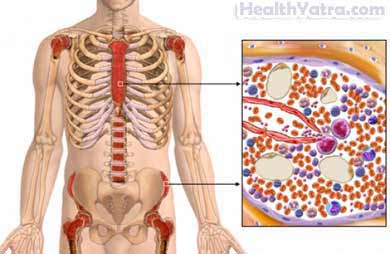परिभाषा
Polycythemia is a condition that occurs when the bone marrow produces an abnormal and excessive amount of red blood cells and platelets in the blood. The abnormal increase of red blood cells in the blood can cause the blood to thicken and clot.
There are several forms of polycythemia—primary polycythemia, secondary polycythemia, and stress polycythemia—and each form has its own set of causes and risk factors.
Primary polycythemia is a serious and chronic condition that requires immediate care from your doctor. No cures exist for this condition, but there are treatment options. It is extremely important that you seek medical attention to establish a treatment plan.

का कारण बनता है
The precise cause of primary polycythemia is unknown. There are no apparent genetic or environmental factors that can be attributed to causing primary polycythemia.
जोखिम कारक
A risk factor is something that increases your chances of getting a disease or condition. The following factors will increase your chances of developing primary polycythemia:
- Sex: male (twice as likely to be affected as women)
- Age: over the age of 40 years old; only very rarely are individuals under the age of 40 diagnosed with primary polycythemia.
- Race: Caucasians
- A history of:
- Abnormal or increased production of platelets in the blood
- Overall increase in the total number of red blood cells in the blood
- Blood clotting or thickening of the blood in the veins and major arteries
लक्षण
The symptoms of primary polycythemia occur gradually and vary from person to person. Some people are asymptomatic (showing no signs of the condition), while others are symptomatic (showing signs of the condition). If you experience any of the following symptoms, do not assume it is due to primary polycythemia. These लक्षण उत्पन्न हो सकते हैं अन्य, कम गंभीर स्वास्थ्य स्थितियों से। यदि आप इनमें से किसी एक का अनुभव करते हैं, तो अपने चिकित्सक से मिलें।
- Abnormal and heavy bleeding due to a cut or a nosebleed
- Intense and frequent bone pain and/or muscle pain
- Headaches, dizziness, or gastrointestinal symptoms
- Difficulty or labored breathing
- The color of the skin appears reddish
- Fatigue (a state of weariness following a period of mental or physical activity)
- Inability to concentrate
- गाउट
- Deep vein thrombosis, heart attack, or stroke
- Intense itching after a warm or hot bath, shower, or any activity that requires soaking your skin in warm or hot water
निदान
Your physician will ask about your symptoms and medical history, and perform a physical exam. You may also be referred to a doctor who specializes in blood diseases and disorders (called a hematologist). The hematologist will perform a series (a set) of tests that may include:
- Complete blood count (CBC) test—to measure your hematocrit level (the proportion of red blood cells in the blood)
- Bone marrow biopsy (where a hollow-needle is inserted into your pelvic bone to remove a sample of your bone marrow cells)—to determine the rate at which the bone marrow is overproducing red blood cells. This test is also used to help determine what type of medication and other treatment options will slow the production of red blood cell in the bone marrow.
उपचार
अपने चिकित्सक के साथ बात के बारे में सबसे अच्छा उपचार योजना के लिए आप. उपचार के विकल्प में निम्न शामिल हैं:
Phlebotomy
Phlebotomy is a technique that requires a person to periodically have blood removed from a vein to decrease the overall total proportion of red blood cells in the body. The frequency of the treatment is based on how quickly a person’s bone marrow produces an excessive amount of red blood cells.
Myelosuppressive Agents
Myelosuppressive agents are drugs taken orally (by mouth) to block or interfere with the formation of new cells. These drugs reduce bone morrow production of cells to decrease platelets and the overall proportion of red blood cells in the body.
कीमोथेरपी
Chemotherapy is a group of drugs that can be given orally (by mouth), by injection, or through a catheter (tubular device that is inserted into a duct or blood vessel) to slow the rapid development of red blood cells in the bone marrow.
रोकथाम
There are no known preventative measures that will reduce your chances of getting primary polycythemia; the condition is not contagious.
There is no cure, but recent research suggests that individuals who have primary polycythemia may significantly increase their overall life expectancy by seeking immediate and timely treatment.
